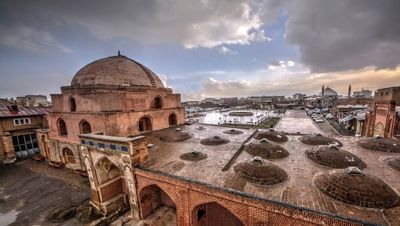In this phase, the brickwork of the walls, plastering of the internal spaces, landscape architecture and rooftops of the Jameh Mosque of Urmia is an on agenda for restoration, a local tourism official said on Friday.
Restoration of the Jameh Mosque of Urmia started in 2014, and up to the moment, actions such as brick paving, insulation of the roof, foundation reinforcement, its dome, facade, and interior decoration amendment have been carried out, the official explained.
Moreover, some archaeological trenches have been carved so far to help experts investigate and analyze the whole structure, the official said.
Jameh Mosque of Urmia has many sections. The first section that a visitor will encounter is two entrances that connect the mosque to a bazaar nearby.
It was built in the Seljuk era, and the famous altar that is located in this section is attributed to the Ilkhanate era. The stucco on the altar is one of the highlights of this building. Chehelsotun Hall, literally meaning a hall with forty columns, is newer than the sanctuary and is connected to it.
The materials used in different parts vary, too. The main materials of the sanctuary and Chehelsotun Hall are bricks mostly seen in the upper parts. There are chambers located around the yard of the Jameh Mosque of Urmia that, according to the tablets over there, belong to 1184 AH, the early years of the Zand era.
Traditionally, mosques and bazaars have long been two important social centers of Iran. Tourists usually visit these places during their trips to Iran for a better understanding of the social aspects and lifestyles of people in each region.
By the advent of Islam, a lot of mosques replaced fire temples. It is said that it was the same for the Jameh Mosque of Urmia. The construction of the building began in the seventh century AH because the pictorial decorations of this mosque, such as stucco, columns, and vaults, match the architectural style of the Seljuk era.
The altar is estimated to be built in 676 AH. During different eras, much damage has been inflicted on the body of the building.
Many repairs have been conducted, too. But their dates are not known. Even though the date of the restoration of this building is not known, this mosque has certainly been repaired and restored along with other old parts of the city, the bazaar in particular.
The terms “Jameh Mosque”, “Masjed-e Jameh” and “Friday Mosque” are used in Iran for a grand communal mosque where mandatory Friday prayers are performed: the phrase is used in other Muslim countries but only in Iran does it designate this purpose.
Source: Tehran Times

